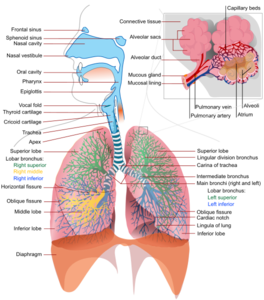Respiratory System
Respiration In Insects, Respiratory System Of Fish, Respiration In Terrestrial Vertebrates, Human Respiratory SystemRespiration in the earthworm

Aerobic organisms take in oxygen from the external environment and release carbon dioxide in a process known as respiration. At the most basic level, this exchange of gases takes place in cells and involves the release of energy from food materials by oxidation. Carbon dioxide is produced as a waste product of these oxidation reactions. The gas exchange in cells is called cellular respiration. In single-celled organisms, the oxygen and carbon dioxide simply diffuse through the cell membrane. Respiration in multicellular organisms, however, is a much more complex process involving a specialized respiratory system that plays an intermediary role between the cells and the external environment. While the respiratory organs of some complex organisms such as insects communicate directly with internal tissues, respiration in vertebrates also involves the circulatory system, which carries gases between cells and respiratory organs.
The respiratory system must meet two important criteria. First, the respiratory surface must be large enough to take in oxygen in sufficient quantities to meet the organism's needs and release all waste gas quickly. Some animals, such as the earthworm, use the entire body surface as a respiratory organ. The internal respiratory organs of vertebrates generally have many lobes to enlarge the surface area. Second, the respiratory membrane must be moist, since gases require water to diffuse across membranes. The watery environment keeps the respiratory surface moist for aquatic animals. A problem exists for land animals, whose respiratory surfaces can dry out in open air. As a result, animals such as the earthworm must live in damp places. Internal respiratory organs provide an environment that is easier to keep moist.
The earthworm uses its moist outer skin as a respiratory organ. Oxygen diffuses across the body surface and enters blood in the dense capillary mesh that lies just below the skin. Blood carries the oxygen to the body cells. There, it picks up carbon dioxide and transports it to the skin capillaries where it diffuses out of the body. The skin is effective as an organ of respiration in small wormlike animals where there is a high ratio of surface to volume.
Additional topics
- Respiratory Diseases - Treatments, Bronchial Diseases, Bronchodilators, Tuberculosis, Pneumonia, Cancer, Miscellaneous Disorders - flu Colds and allergies
- Respiratory System - Respiration In Insects
- Respiratory System - Respiratory System Of Fish
- Respiratory System - Respiration In Terrestrial Vertebrates
- Respiratory System - Human Respiratory System
- Respiratory System - The Respiratory Tract
- Respiratory System - The Lungs
- Respiratory System - Pulmonary Ventilation
- Respiratory System - Respiratory Disorders
- Other Free Encyclopedias
Science EncyclopediaScience & Philosophy: Reason to Retrovirus